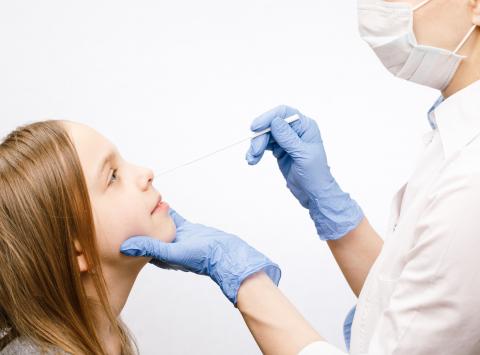Bright Futures
Articles and Updates from Phoenix Children's
All patients being admitted to Phoenix Children's Hospital or having a surgery must receive a COVID-19 swab. And we know that these swab tests can be a challenge: It’s important to help our patients and families find the best ways to cope with this type of procedure.
Even though COVID-19 tests are new, we can use the skills that have been proven to work over many years of research.
Prepare your child on what to expect (this will depend on age and cognitive level)
Explain what the test is. Saying things like “This test will help let us know if you have this virus” and “We have to learn this so we know the best way to keep you safe and healthy” will help you provide your child with some context and perspective. You can then explain what will happen next. This can include length of time and the equipment used by medical staff. Saying “The doctors and nurses will be wearing masks and gowns. They will use something like a long Q-tip to touch the inside of your nose while they count to ten” will give them a better idea of what will happen and how long it will take, in words and metrics they can understand. You should also share expectations, like “You need to stay as still as possible” and “Let’s see who can be as still as a statue. Go!” These tools will involve you in the process and help them feel less alone. You, as the caregiver, will be with them every step of the way.
Practice coping skills ahead of time
Even the smartest child does not think or cope like an adult. Adults know the test will be over quickly and holding still will make the procedure as painless as possible. A child knows that having a swab in their nose doesn’t feel good and wants it to stop. However, if you give children some key coping skills and practice those skills with them during the procedure, it will be a much easier process for everyone involved.
Prior to testing, ‘medical play’ can especially help younger children appropriately understand and expect what will happen. Depending on your child’s age, you can add some medical play with stuffed animals and other toys. Let your child pretend to swab their stuffed animal with a Q-tip while you narrate the coping skills the animal is using like, “Bear wants to sit in my lap to help her stay still. Does she want to count out loud with us?” Figure out where your child will be most comfortable: Usually, your child will want to sit in your lap with their back against your chest. You might want to turn your head to the side to protect your chin just in case your child gets startled and pulls his/her head back quickly.
Importantly, you can educate others and advocate for your child that research unmistakably demonstrates children should never be held down during procedures.
If you have to do drive-thru testing, join your child in the back of the car. Remove them from the car seat before the test. You don’t want them to associate the car seat with a possibly stressful experience of receiving a nasal swab when they likely have to use the car seat daily.
You can practice deep breathing, or you can call it “slow, soft” breathing ahead of time. One way is the classic approach of using bubbles, which also provides something they can see and touch. You can also practice progressive muscle relaxation before the swab. To practice, ask your child to tighten each muscle at a time very slightly, for about five seconds, and then let them loosen and relax for 10 seconds. The muscle groups can range from forehead, nose, shoulders, arms, stomach and legs. Basically, anywhere you can squeeze and relax a muscle. Another trick involves Play-Doh or Model Magic. Have your child squeeze the Play-Doh for five seconds, which brings their attention to the Play-Doh’s movement through their fingers. Have your child relax their hands for 10 seconds and repeat as many times as you would like.
You can always use your child’s five senses: These sensory stimuli “compete” against the negative sensory input of the swab experience. These could be electronics, videos, a favorite toy, singing a song, guided imagery. You can bring in other senses, via a forehead or hand massage. You could use a fidget toy or guide them by describing the sensations of feeling, touching or seeing a favorite stuffed animal they bring with them to their testing.
And just like practicing coping ahead of time, positive reinforcement is another great strategy. Work with your child to choose some sort of prize (e.g., small toy or treat, extra time playing games, getting to pick a show or movie at home, picking a book to read, etc.) ahead of time and reinforce their good behavior during the test with the special treat.
Language is key
One thing caregivers can control is their language. Be mindful of what you say leading up to and during the nasal swab. For example, many times parents or medical providers will make statements like, “This will be very quick” or “Don’t worry. You’ll be fine” or “Just relax.”
If we think about these statements, who are they really for? Whose anxiety do they really ease? It is our own, as the adults trying to help the child hurry and make it through this difficult experience. Instead, provide honest, positive reinforcement to praise the child for whatever they are doing correctly in-the-moment such as, “Great job sitting still!” or “Thank you for listening.”
Caregivers and providers can also use positive statements like, “Let's help loosen those muscles” vs. making prescriptive statements like, “Don't tighten your body.” Again, we (whether caregivers or providers) do not want to repeatedly tell a child, “You’re doing great” when they are having a meltdown. This actually creates more fear and distrust for the patients and can make the current or likely future situations worse. Children are smart! They know you are lying even if they cannot necessarily communicate it. We also do not want to punish or scold children for crying. Crying is an age-appropriate reaction. However, we don’t want children to be screaming, flailing or being held down because that, in turn, can make this event a traumatic experience. One traumatic experience often results in fear of medical personnel or appointments in the future. Remember, when our bodies are in a heightened state of stress (i.e., a swab up our nose), the nervous system, muscles and senses are evolutionarily primed to code and remember everything going on in order to avoid it in the future if it is deemed too threatening.
Another helpful tool is using “forced-choice” decision-making. For example, instead of saying, “Just breathe” or “Don’t tighten up” or “Do you want to do deep breathing,” try, “Let’s choose between belly breathing or watching a video – which do you want?” Again, we want to make sure it’s not in the form of a yes-no question, because we know how kids will usually respond, especially in a stressful situation.
Each child is individual and brings their own history and context to be aware of, but as a caregiver, you can tap into years of work with thousands of pediatric patients and caregivers to help bring comfort and confidence to your child (along with yourself) when coping with this procedure.
Check out this helpful “Game Plan”
https://www.megfoundationforpain.org/s/COVID-swab-game-plan-1.pdf
References
Thomas, Jody, & Gentille, Jamie. “Nasal swabs: Creating Comfort and Preventing Pain for Little (and Big!) People.” https://www.megfoundationforpain.org/covid-19-resources
Taddio, A., Appleton, M., Bortolussi, R., Chambers, C., Dubey, V., et al. (2010). Reducing the pain of childhood vaccination: an evidence-based clinical practice guideline. CMAJ, 182(18), E843-E855. doi 10.1503/cmaj.101720.




